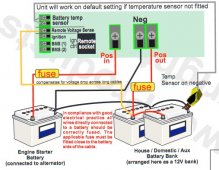Hi guys,
Looking to install a Sterling BB1260 in my Sprinter van. My house battery bank is made up for (2) 200Ah 12V LiFePO4 in parallel for a 400Ah 12V bank. This bank is a floating system, nothing is grounded to the vehicle chassis. All of the electrical devices connect to my pos and neg bus bars.
It would appear from my internet reading that charging this type of ungrounded house system from the vehicle alternator/starter battery is a no-no. Would you guys agree? The Sterling will be connected to the Starter battery rather than directly to the alternator...does this make difference? Would I be okay leaving my house system isolated? If not.is my solution to simply run a wire from the house neg bus bar to an appropriate grounding point on the vehicle chassis?
If all the above is true, what gauge should I use considering the size of my bank? There's really no convenient place to run the ground wire to the chassis..my batteries are located inside the Sprinter all the way in the rear.
Thanks very much for any help
Looking to install a Sterling BB1260 in my Sprinter van. My house battery bank is made up for (2) 200Ah 12V LiFePO4 in parallel for a 400Ah 12V bank. This bank is a floating system, nothing is grounded to the vehicle chassis. All of the electrical devices connect to my pos and neg bus bars.
It would appear from my internet reading that charging this type of ungrounded house system from the vehicle alternator/starter battery is a no-no. Would you guys agree? The Sterling will be connected to the Starter battery rather than directly to the alternator...does this make difference? Would I be okay leaving my house system isolated? If not.is my solution to simply run a wire from the house neg bus bar to an appropriate grounding point on the vehicle chassis?
If all the above is true, what gauge should I use considering the size of my bank? There's really no convenient place to run the ground wire to the chassis..my batteries are located inside the Sprinter all the way in the rear.
Thanks very much for any help
Last edited:



